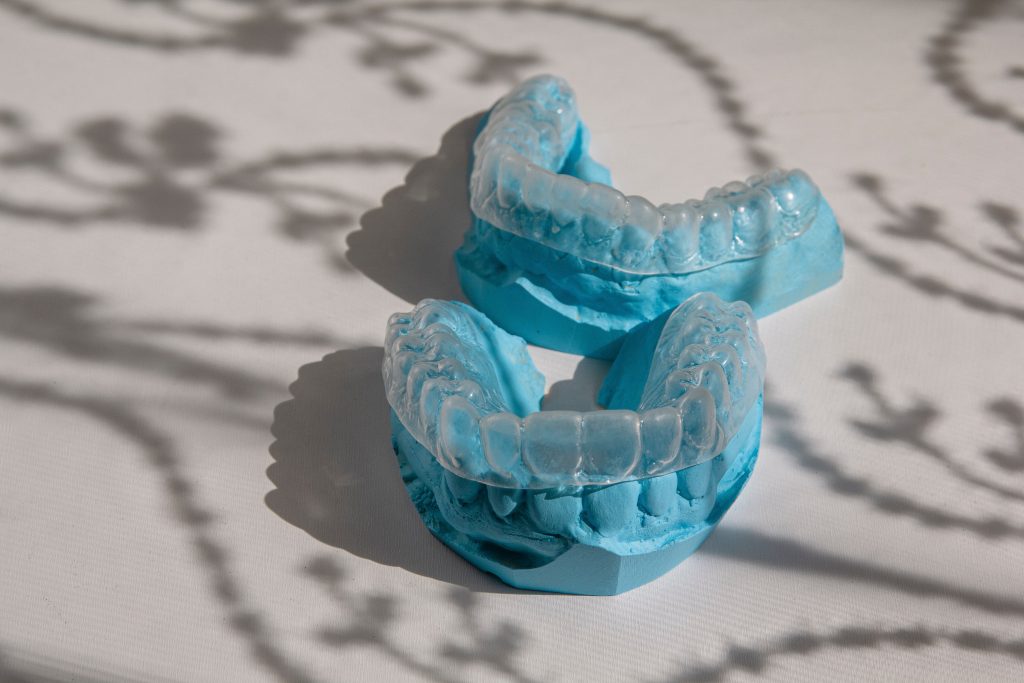Night Guard and Splint
- Home
- TMD and Anti-Aging Treatment
- Night Guard and Splint
This device is commonly used by people who suffer from bruxism, or excessive nighttime tooth grinding or clenching. This grinding and clenching puts pressure on the jaw, which can cause temporomandibular joint (TMJ) problems, severe headaches, ear pain, and neck pain as well as causing excessive wear to the teeth.

Thin, transparent, and horseshoe-shaped, dental night guards are created from hard but moldable plastics. The night guard fits over either the upper or the lower teeth, creating a cushion between them and absorbing the impact of the grinding or clenching. Night guards can help reduce enamel damage, jaw joint inflammation, and irritation to the gums.
How Night Guards Help
Overall, most night guard wearers report they have less pain and sleep better.
In order to be truly effective, night guards need to be custom-made for each individual. It typically takes two appointments to receive a night guard. During the initial visit, we take a bite record and make an impression of your teeth. These will be used to create a customised night guard that allows for proper teeth alignment. During the second appointment, we give you a test run and make the necessary adjustments.
Care of Night Guards
Night guards can last up to ten years if they are given proper care. Night guards should always be rinsed just before and just after wearing, and they need to be brushed with a soft toothbrush and non-abrasive toothpaste or denture cleaner once a day. They should also be soaked in denture cleaner once a week to keep them clean and fresh.
Dental Splints
The term “dental splint” is used to refer to several types of orthodontic devices which are designed to address dental problems such as loose teeth and bruxism.
Dental splinting, used to treat loose teeth, involves joining teeth together. The splint stabilizes teeth so that they are less likely to move, which can weaken the teeth and cause them to fall out. Splinting may be used for temporary stabilisation of loose teeth, or to address ongoing issues; it is important to address the underlying cause of the looseness, as a dental splint cannot resolve a dental problem.
For people with TMJ and bruxism, a dental splint is used to protect the teeth from damage at night. The hard splint is worn like a mouthguard fitted over the top or bottom teeth, depending on your needs.
Snoring and sleep apnea can also sometimes be addressed with the use of a dental splint. A properly fitted splint can keep the airway clear, reducing breathing problems at night.
Care of Splints
Like other types of devices worn in the mouth, a dental splint must receive proper care. Dirty splints can spread infection, which can be a serious problem for the patient, and splints which are not stored and handled properly may deform, which can put stress on the teeth and jaw. Care directions and a case for storing the splint when it is not in use are usually provided by the dentist who fits the splint. The dentist may recommend follow up visits to confirm that the splint fits properly and is in good condition.
Patients who experience problems such as dental pain while wearing a dental splint should report these problems to their dentists. For more information please contact our office on 1300 32 TEETH.
Book an Appointment for Consultation.
View Our Gallery

Before and After Treatment Results by Latest Technology
Dental hygiene is the practice of keeping the mouth and teeth clean to prevent dental problems, like cavities, gingivitis, and bad breath. Good oral hygiene is required for healing and regeneration of the oral tissues following a dental procedure.

Before and After Treatment Results by Latest Technology
Dental implants are designed to replace one or more teeth. The implants are made of titanium, biocompatible material that is not rejected by the body. The implants hold up the natural bone, stabilising the jaw bone levels and minimise further bone loss. The implants are placed through a quick and minimally invasive procedure.

Before and After Treatment Results by Latest Technology
Periodontology focuses on prevention, diagnosis and treatment of diseases of the supporting and investing structures of the teeth including the gums, cementum, periodontal membranes, and alveolar bone. Diseases affecting the rest of the body, known as systemic diseases, can weaken the supporting structures of the teeth.

Before and After Treatment Results by Latest Technology
Cosmetic dentistry addresses aesthetic issues that can make you feel selfconscious like stained, chipped and gapped teeth. Cosmetic dental treatments can improve the colour, position, shape, size, alignment and overall smile appearance.

Before and After Treatment Results by Latest Technology
Orthodontics corrects teeth and jaw alignment problems using devices such as braces, special fixed and removable appliances, fixed and removable space maintainers, and invisible aligners. If you have crowded teeth, spacing, an underbite, overbite, crossbite, openbite, or a misplaced midline, orthodontics could be for you.

Before and After Treatment Results by Latest Technology
A denture is a removable appliance which is worn to replace lost or missing teeth. Two types of dentures are available, complete and partial dentures. Complete dentures are used when all the teeth are missing, while partial dentures are used when some natural teeth remain.

Before and After Treatment Results by Latest Technology
Your dentist can suggest various treatments to prevent potential problems and to restore damaged teeth. These treatments help restore the appearance, shape and function of your teeth, and can help prevent the build up of plaque acids on the enamel surface of teeth and are of value in the prevention of tooth decay.

Before and After Treatment Results by Latest Technology
At Star Smiles we offer many dental procedures including gum lifts, tooth extractions, and other surgical procedures. We offer the latest laser dentistry that eliminates the need for stitches, minimises bleeding, and sterilises the area on-the-go to minimise the risk of infection.
